
Introduction
One of BenQ's latest displays is the 35"
ultrawide EX3501R. This screen is aimed at entertainment and "video enjoyment",
focusing in the marketing material on its panoramic 21:9 aspect ratio,
HDR
(High Dynamic Range) capabilities eye-care. We will talk about the level of
HDR support on this screen later in the review, but looking at the BenQ spec
page for this Ultrawide curved monitor,
you can tell that it seems to be the prime focus. They also talk about their
'Opt-clarity' technology which combines HDR support with their 'Brightness
Intelligence Plus" (B.I.+) for helping to improve the viewer experience and
soften bright areas while keeping dark areas crystal clearer even in dimly lit
environments. Anyway, we will talk more about HDR support later in the review.
The EX3501R is a large 35" sized display and
offers a 3440 x 1440 resolution VA technology panel. This allows for high static
contrast ratios and deep blacks, one of the key strengths of VA technology. This
is combined with a 100Hz native refresh rate for gaming, and support for
Adaptive-Sync. This means you can use the screen for variable refresh rates (VRR)
on AMD graphics cards, and thanks to the
recent NVIDIA driver update, now also from NVIDIA cards if you want to try
it (although not one of the certified G-sync Compatible displays). There is
BenQ's usual focus on eye-care on this monitor, with a flicker free backlight
and low blue light modes provided. More information about their monitor range
can be found on BenQ's
website.
If you
would like to help support our continued work please consider making a
donation
no matter how small or large. Thank you.

|
Check Pricing and Buy - Affiliate Links
|
|
Amazon |
Overclockers UK
|
|
TFTCentral is a participant
in the Amazon Services LLC Associates Programme, an affiliate
advertising programme designed to provide a means for sites to earn
advertising fees by advertising and linking to Amazon.com, Amazon.co.uk,
Amazon.de, Amazon.ca and other Amazon stores worldwide. We also
participate in a similar scheme for Overclockers.co.uk. |

Specifications and
Features
The following table gives detailed
information about the specs of the screen as advertised:
|
Monitor
Specifications |
|
Size |
35" Ultrawide |
Panel Coating |
Light AG coating |
|
Aspect
Ratio |
21:9 curved 1800R |
Interfaces |
1x
USB type-C
1x DisplayPort 1.4
2x HDMI 2.0
2x USB 3.0 hub
1x headphone out
|
|
Resolution |
3440 x 1440 |
|
Pixel Pitch |
0.2384mm |
Design
colour |
3 side borderless design
with matte black edges. matte silver back, and shiny silver coloured stand |
|
Response Time |
4ms G2G |
Ergonomics |
Tilt, 60mm height, swivel |
|
Static Contrast Ratio |
2500:1 |
|
Dynamic Contrast Ratio |
20 million:1 |
VESA Compatible |
Yes |
|
Brightness |
300 cd/m2 |
Accessories |
DisplayPort, HDMI and USB
type-C cables. Power cable and brick |
|
Viewing Angles |
178 / 178 |
|
Panel Technology |
AU Optronics AMVA (VA-type) |
Weight |
with stand: 10.4 Kg |
|
Backlight Technology |
W-LED |
Physical Dimensions |
(WxHxD) with stand
833.95 x 444.02 - 504.02 x 224.08 mm |
|
Colour Depth |
16.7m (8-bit) |
|
Refresh Rate |
100Hz native |
Special
Features |
AMD FreeSync, ambient light
sensor, PiP/PbP modes |
|
Colour
Gamut |
100% sRGB standard gamut
spec |
The EX3501R offers a very good range of
connectivity with 1x DisplayPort 1.4, 2 x HDMI 2.0 and USB type-C offered
for video connections. There is an additional 2 port USB 3.0 hub, with the ports located
on the back of the screen with the other connections. The screen has an external power supply and
comes packaged with the power cable and brick you need. A headphone output
connection is provided as well for audio pass-through.
Below is a summary of the features and
connections of the screen:
|
Feature |
Yes / No |
Feature |
Yes / No |
|
Tilt adjust |
 |
DisplayPort |
 |
|
Height adjust |
 |
HDMI |
 |
|
Swivel adjust |
 |
USB type-C |
 |
|
Rotate adjust |
 |
DVI |
 |
|
VESA mounting compliant |
 |
D-sub |
 |
|
USB Ports |
 |
Audio/headphone out |
 |
|
Card Reader |
 |
HDCP Support |
 |
|
Ambient Light Sensor |
 |
MHL Support |
 |
|
Human Motion Sensor |
 |
Integrated Speakers |
 |
|
Touch Screen |
 |
PiP / PbP |
 |
|
Factory calibration |
 |
Blur Reduction Mode |
 |
|
Hardware calibration |
 |
NVIDIA G-Sync |
 |
|
Uniformity correction |
 |
AMD FreeSync |
 |
|
Wireless charging |
 |
Meaningful HDR |
 |

Design and
Ergonomics

Above: front view of the screen. Click for larger version
The EX3501R comes in a black and silver design
with matte plastics used along the edges, back and arm for the
stand. The legs of the stand are a shiny silver plastic, as is the round cable
tidy hole in the arm.

Above: front views of the screen. Click for larger versions
This model has a 3 side
borderless design with a thin black plastic edge around the sides and top,
measuring ~2mm. There is a 8mm black panel border as well, so the total
black edge around the sides and top is ~10mm. Along the bottom edge the black
plastic bezel is
thicker at ~23mm, with a smaller 3mm black panel edge creating a total border of
~26mm. There is a shiny silver coloured "BenQ" logo
in the middle of the bottom bezel.

The stand is attached in the middle of the
back of the screen and features a round cable tidy hole in the arm. The shiny
silver feet of the screen provide a wide and sturdy base for the large display,
and are not too deep even on a relatively shallow desk.

Above: rear views of the screen. Click for larger versions
The back of the screen is encased mostly in a
smooth, rounded, matte
silver plastic, with a patterned black section along the bottom. The connections are
tucked under the curved silver part of the casing.


Above: side profile of the screen. Click for larger versions
The screen has a pretty thin profile thanks
to the W-LED backlight and the external power supply (brick and cable
provided in the box). The above pictures look a bit thicker because of the
screens curvature though of course.

There is a moderate range of ergonomic
adjustments offered by the stand. Tilt offers a pretty wide range and is smooth to
move, but a little stiff to operate. There is a fairly limited 60mm height adjustment which is
a smooth, but quite stiff to move. At the lowest setting the bottom edge of the screen is
60mm from
the top of the desk, and 120mm when at maximum height extension. We felt that
the maximum height was a little limited, although we could still get it to a
comfortable viewing position for our day to day use. Side to side
swivel is not provided sadly, which can be useful on any desktop display.
Rotation is not included, but not missed on such a wide format screen with a
curve. The stand was very stable and sturdy, and there was very little wobble
from the screen which was pleasing.
A summary of the ergonomic adjustments are
shown below:
|
Function |
Range |
Smoothness |
Ease of
Use |
|
Tilt |
Yes |
Smooth |
A little stiff |
|
Height |
60mm |
Smooth |
Quite stiff |
|
Swivel |
No |
- |
- |
|
Rotate |
No |
- |
- |
|
Overall |
Reasonable enough with
tilt and height. Height adjustment a little limited, and we missed side to
side swivel. Stand was sturdy with very little wobble. |
The materials were of a good
standard and the build quality felt good. There was no audible noise from the
screen, even when conducting specific tests which can often identify buzzing
issues. The whole screen remained cool even during prolonged use as well which
was pleasing.

The back of the screen features the
connections. There are the 1x DisplayPort 1.4, 2x HDMI 2.0, 1x USB Type-C, 2x USB
3.0 downstream, headphone out and the power supply input. Note that to use the
two USB 3.0 downstream ports you will need to connect the monitor to your PC
using the USB type-C connection as there's no separate USB upstream
connection.
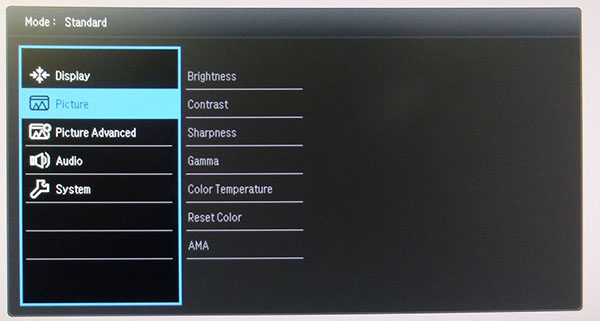
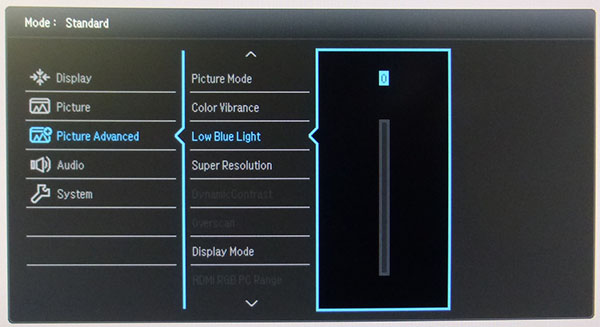
The
OSD is controlled through 6 pressable buttons located on the bottom edge of
the screen, as you can see from the image above. There is also a larger power
button which glows white during operation, and amber in standby. You can't see
any of these buttons from a normal viewing position, you have to reach
underneath the bottom edge of the screen to use them. The button closest to
the power button is actually an input selection, and can't be used for
anything else in the menu navigation. The other 5 are used to get to the quick
access menus and the main menu.
There is quick access to 3 different settings, brightness, contrast and the
preset mode. You can actually customise these in the main OSD if you want
access to a few other settings like volume or low blue light modes. The main
menu presents a lot more options to pay with. Navigation was easy and felt
intuitive, with good on-screen guidance at the bottom of the display to make
it clear which button would do what. We only found ourselves accidentally
pressing the input selection a couple of times, as the OSD labels were pretty
helpful to directing you to the correct buttons you wanted.

Power Consumption
In terms of power consumption the
manufacturer lists a typical usage of 65.7W but no other specs.
We carried out our normal tests to establish its power consumption ourselves.
|
 |
|
State and Brightness Setting |
Manufacturer Spec (W) |
Measured Power Usage (W) |
|
Default (100%) |
65.7 |
58.5 |
|
Calibrated (22%) |
- |
33.4 |
|
Maximum Brightness
(100%) |
- |
58.5 |
|
Minimum Brightness
(0%) |
- |
26.2 |
|
Standby |
- |
0.6 |
|
Out of the box the screen used 58.5W at the
default 100% brightness setting. Once calibrated the screen reached
33.4W
consumption, and in standby it used only 0.6W. We have plotted these results
below compared with other screens we have tested. The consumption (comparing the
calibrated states) is comparable to the other 34 - 35" ultrawide sized screens here,
being a little more than most of the smaller ultrawide 27" models.


Panel and Backlighting
|
Panel Manufacturer |
AU Optronics |
Colour Palette |
16.7 million |
|
Panel Technology |
AMVA (VA-type) |
Colour Depth |
8-bit |
|
Panel Module |
M350QVR01.1 |
Colour space |
Extended gamut |
|
Backlighting Type |
W-LED |
Colour space coverage (%) |
100% sRGB quoted
115% sRGB measured (85% DCI-P3) |
Panel Part and Colour Depth
The BenQ EX3501R features an
AU Optronics M350QVR01.1 AMVA (VA-type) technology panel. The panel
offers an 8-bit colour depth, producing 16.7 million colours and is confirmed
when dismantling the screen as shown below.
|
|
Key
Quick Information Box
-
AU
Optronics VA technology panel
-
8-bit
colour depth
-
Although not advertised, backlight produces wider than standard gamut at ~115% sRGB /
85% DCI-P3
-
Flicker free backlight operation
|
|

Screen
Coating
The
screen coating is a light anti-glare (AG) offering. It isn't a semi-glossy
coating, but it is light as seen on other modern VA type panels. Thankfully it
isn't a heavily grainy coating like some old IPS panels feature and is also
lighter than TN Film panel coating. It retains its anti-glare properties
to avoid too many unwanted reflections of a full glossy coating, but does not
produce too grainy or dirty an image that some thicker AG coatings can.
Backlight Type and Colour Gamut
The screen uses a White-LED (W-LED) backlight
unit which is standard in today's market. This helps reduce power consumption
compared with older CCFL backlight units and brings about some environmental
benefits as well. According to the spec pages for this screen the W-LED unit offers
only a standard colour gamut which is
equal to 100% of the sRGB colour space. In fact our independent measurements in
the following sections confirmed the gamut was wider than this, covering around
115% sRGB, and representing about 85% of the DCI-P3 colour space.
Anyone wanting to work with even wider
colour spaces would need to consider some of the wide gamut displays available
instead. Considering the screen is heavily promoted for its use with HDR content
we might have expected BenQ to promote this extended colour space a bit more. It
doesn't meet the >90% DCI-P3 requirements usually considered for HDR, but it's
wider than a normal sRGB screen. If you want to read more
about colour spaces and gamut then please have a read of our
detailed article.
Backlight
Dimming and Flicker
We tested the screen to establish the methods
used to control backlight dimming. Our in depth article talks in more details
about a previously very common method used for this which is called
Pulse Width Modulation (PWM). This in itself gives cause for concern to some
users who have experienced eye strain, headaches and other symptoms as a result
of the flickering backlight caused by this technology. We use a photosensor +
oscilloscope system to measure backlight dimming control with a high level of
accuracy and ease. These tests allow us to establish
1) Whether PWM is being used to control the
backlight
2) The frequency and other characteristics at which this operates, if it is used
3) Whether a flicker may be introduced or potentially noticeable at certain
settings
If PWM is used for backlight dimming, the
higher the frequency, the less likely you are to see artefacts and flicker. The
duty cycle (the time for which the backlight is on) is also important and the
shorter the duty cycle, the more potential there is that you may see flicker.
The other factor which can influence flicker is the amplitude of the PWM,
measuring the difference in brightness output between the 'on' and 'off' states.
Please remember that not every user would notice a flicker from a backlight
using PWM, but it is something to be wary of. It is also a hard thing to
quantify as it is very subjective when talking about whether a user may or may
not experience the side effects.
100%
50%
0%



Above scale
= 1 horizontal grid = 5ms
At all brightness settings a constant
Direct Current (DC) voltage is applied to the backlight, and the screen is
free from the obvious off/on switching of any PWM dimming method. As a result,
the screen is flicker free as advertised.
|
Pulse
Width Modulation Used |
No |
|
Cycling
Frequency |
n/a |
|
Possible Flicker at |
|
|
100% Brightness |
No |
|
50% Brightness |
No |
|
0% Brightness |
No |

Brightness
and Contrast
This
section tests the full range of luminance (the brightness of the screen)
possible from the backlight, while changing the monitors brightness setting in
the OSD menu. This allows us to measure the maximum and minimum adjustment
ranges, as well as identify the recommended setting to reach a target of 120
cd/m2 for
comfortable day to day use in normal lighting conditions. Some users have
specific requirements for a very bright display, while others like a much
darker display for night time viewing or in low ambient light conditions. At
each brightness level we also measure the contrast ratio produced by the
screen when comparing a small white sample, vs. a black sample (not
unrealistic full screen white vs. full screen black tests). The contrast ratio
should remain stable across the adjustment range so we also check that.
Graphics card settings were left at
default with no ICC profile or calibration active. Tests were made using an
X-rite i1 Display Pro colorimeter. It should be noted that we used the
BasICColor calibration software here to record these, and so luminance at
default settings may vary a little from the LaCie Blue Eye Pro report you will
see in other sections of the review.
|
OSD
Brightness |
Luminance
(cd/m2) |
Black Point (cd/m2) |
Contrast Ratio
( x:1) |
|
100 |
310.46 |
0.16 |
1940 |
|
90 |
285.85 |
0.15 |
1906 |
|
80 |
261.45 |
0.14 |
1867 |
|
70 |
236.36 |
0.12 |
1970 |
|
60 |
210.63 |
0.11 |
1915 |
|
50 |
184.19 |
0.10 |
1842 |
|
40 |
157.99 |
0.08 |
1975 |
|
30 |
129.82 |
0.07 |
1855 |
|
20 |
100.71 |
0.05 |
2014 |
|
10 |
70.56 |
0.04 |
1764 |
|
0 |
39.30 |
0.02 |
1965 |
|
Total Luminance Adjustment Range
(cd/m2) |
271.16 |
Brightness OSD setting
controls backlight? |
 |
|
Total Black Point Adjustment Range (cd/m2) |
0.14 |
|
Average Static Contrast Ratio |
1910:1 |
PWM Free? |
 |
|
Recommended OSD setting for 120 cd/m2 |
27 |
At the full brightness setting in the OSD the
maximum luminance reached a high 310
cd/m2
which was a little higher than the specified maximum brightness of 300 cd/m2
from the manufacturer. There was a good 271 cd/m2 adjustment range in
total, so at the minimum setting you could reach down to a low luminance of 39 cd/m2. This should be low enough for most people including
those wanting to work in darkened room conditions with low ambient light. A
setting of 27 in the OSD
menu should return you a luminance of around 120 cd/m2 at default
settings.
It should be noted
that the brightness regulation is controlled without the need for
Pulse Width Modulation for all brightness settings so the screen is flicker
free.


We have plotted the
luminance trend on the graph above. The screen behaves as it should, with a reduction in the luminance output of the screen controlled by the
reduction in the OSD brightness setting. This is basically a linear relationship.
The average contrast ratio of the screen
was measured at 1910:1 before calibration, which was very good thanks to the VA panel, although a
little less than the specified 2500:1 from the manufacturer.

Testing
Methodology
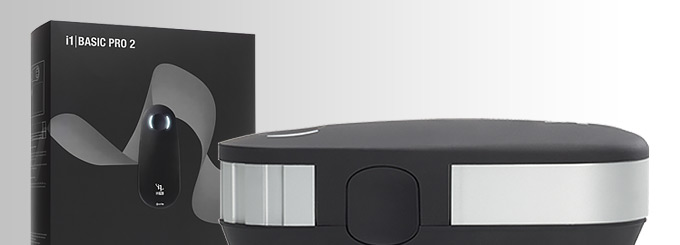
An important thing to consider for most users
is how a screen will perform out of the box and with some basic manual
adjustments. Since most users won't have access to hardware colorimeter tools,
it is important to understand how the screen is going to perform in terms of
colour accuracy for the average user.
We restored our graphics card to default
settings and disabled any previously active ICC profiles and gamma corrections.
The screen was tested at default factory settings using our new
X-rite i1 Pro 2
Spectrophotometer combined with
LaCie's Blue Eye Pro software suite. An X-rite i1 Display Pro colorimeter
was also used to verify the black point and contrast ratio since the i1 Pro 2
spectrophotometer is less reliable at the darker end.
Targets for these tests are as follows:
-
CIE Diagram - confirms the colour
space covered by the monitors backlighting in a 2D view, with the black triangle
representing the displays gamut, and other reference colour spaces shown for
comparison
-
Gamma - we aim for 2.2 which is the
default for computer monitors
-
Colour temperature / white point - we
aim for 6500k which is the temperature of daylight
-
Luminance - we aim for 120
cd/m2,
which is the recommended luminance for LCD monitors in normal lighting
conditions
-
Black depth - we
aim for as low as possible to maximise shadow detail and to offer us the best
contrast ratio
-
Contrast ratio -
we aim for as high as possible. Any dynamic contrast ratio controls are turned
off here if present
-
dE average / maximum
- we aim for as low as possible.
If DeltaE >3, the color displayed is significantly different from the
theoretical one, meaning that the difference will be perceptible to the viewer.
If DeltaE <2, LaCie considers the calibration a success; there remains a slight
difference, but it is barely undetectable. If DeltaE < 1, the color fidelity is
excellent.

Default Performance
and Setup
Default settings of the screen were as follows:
BenQ
EX3501R
Default Settings



|

 |
|
Monitor
OSD Default Settings |
|
|
Picture Mode |
Standard |
|
Brightness |
100 |
|
Contrast |
50 |
|
Color Temperature |
Normal |
|
Gamma |
3 |
|
RGB |
n/a |
|
Luminance
Measurements |
|
|
luminance (cd/m2) |
321 |
|
Black Point (cd/m2) |
0.17 |
|
Contrast Ratio |
1940:1 |
|
Colour
Space Measurements |
|
|
sRGB coverage |
114.9% |
|
DCI-P3 coverage |
84.7% |
|
Rec.2020 coverage |
60.8% |
|
|
Initially out of the box the screen was set
with the 'Standard' picture mode (various presets for different uses) and the
other settings listed in the table above for gamma and colour temperature. The
display was set with a maximum 100% brightness which was too bright and uncomfortable to use. You
will definitely need to turn that down. The colours felt bright and well
balanced. Unless comparing the screen side by side with a normal sRGB screen,
you couldn't really detect any major changes in the colour appearance from the
wider colour gamut in normal uses. They looks bright and vivid, but not
over-saturated.
We went ahead and measured the default state
with the i1 Pro 2. The
CIE diagram
on the left of the image confirms that the monitors colour gamut (black
triangle) extends a little way beyond the sRGB colour space reference
(orange triangle). We measured using ChromaPure software a 114.9% sRGB gamut
volume coverage which corresponds to 84.7% of the DCI-P3 reference and 60.8% of the
Rec.2020 reference. BenQ don't really promote the extended colour gamut on
their product pages, but this ~85% DCI-P3 colour space is useful for HDR content
and to give the screen a bit of a boost in colour vividness that many gamers and
multimedia users will like.
|
|
Key
Quick Information Box
-
Reasonable gamma setup
-
Colour
temp also reasonable, but a bit too warm
-
Strong
VA contrast ratio of 1940:1 out of the box
-
Confirmed wider colour gamut ~85% DCI-P3 coverage
-
No
direct sRGB emulation mode
|
|
There is an sRGB picture mode preset on this
screen, but it does not offer any emulation of the smaller sRGB colour space. In
fact the default setup of that preset is very close to the standard mode
measured above. This means you cannot move to a standard, smaller gamut if you wanted
to. You will always have that larger colour space. For a lot of people they will
prefer that more colourful and vivid appearance for the intended gaming and
multimedia uses, and on the EX3501R it is only a pretty modest extension of the
colour space anyway. Not something most people need to worry about we don't
think.
Default gamma was recorded at 2.3 average
with a moderate 6% overall deviance from the target which was acceptable. White point was measured
at a little-too-warm 6147k, being 5% out from our target. Luminance at the default 100%
brightness level was recorded at a very bright 321
cd/m2
which is too high for prolonged general use, you will need to turn that
down. The black depth was 0.17 cd/m2
at this default brightness setting, giving us a strong static contrast ratio of
1940:1 thanks to the VA panel.
Colour accuracy measurements show a dE
average of 2.2 which was pretty good but keep in mind that the screens wider
gamut output is being compared here with an sRGB reference so will be skewed as
a result. Testing the screen
with colour gradients showed smooth gradients with some minor gradation evident
in the darker tones. There was no sign of any colour banding which was good
news.

Calibration
We used the
X-rite i1 Pro 2
Spectrophotometer combined with the LaCie Blue Eye Pro software package to
achieve these results and reports. An X-rite i1 Display Pro colorimeter was used
to validate the black depth and contrast ratios due to lower end limitations of
the i1 Pro device.
BenQ
EX3501R
Calibrated
Settings
 

|

 |
|
Monitor
OSD Default Settings |
|
|
Picture Mode |
Custom 1 |
|
Brightness |
22 |
|
Contrast |
50 |
|
Color Temperature |
User Define |
|
Gamma |
2 |
|
RGB |
100, 98, 97 |
|
Luminance
Measurements |
|
|
luminance (cd/m2) |
119 |
|
Black Point (cd/m2) |
0.07 |
|
Contrast Ratio |
1747:1 |
|
Colour
Space Measurements |
|
|
sRGB coverage |
114.9% |
|
DCI-P3 coverage |
84.7% |
|
Rec.2020 coverage |
60.8% |
|
We had to change the picture mode preset to
one of the 'custom' modes to be able to access the manually configurable colour
temperature mode. We changed the gamma to mode 2 as well, as we measured this to
be by default a bit closer to our target with only a small 1% deviance. By
changing to the 'custom' preset mode we could enter the 'User define' colour
temperature mode as well, which gave us access to alter the RGB channels
directly. The OSD settings were
adjusted as shown in the table above, as guided during the calibration process
and measurements.
These OSD changes allowed us to obtain an optimal hardware starting point and
setup before software level changes would be made at the graphics card level. We
left the LaCie software to calibrate to "max" brightness which would just
retain the luminance of whatever brightness we'd set the screen to, and would
not in any way try and alter the luminance at the graphics card level, which can
reduce contrast ratio. These adjustments before profiling the screen would help
preserve tonal values and limit banding issues. After this we let the software
carry out the LUT adjustments and create an
ICC profile.
Average gamma was measured at 2.2 average (leaving
a 0%
deviance) and sorting out the differences that we'd seen out of the box
where a 6% deviance had been measured. The white point had now been corrected to 6513k which had fixed
the too warm 5% deviance we'd seen before. Luminance had been improved thanks to
the adjustment to the brightness control and was now being measured at a far
more comfortable 119
cd/m2.
This left us a black depth of 0.07 cd/m2 and maintained a strong static contrast ratio
of 1747:1 thanks to the VA panel. This had dipped a bit because of the RGB adjustments and gamma curve
correction but still surpassed any IPS or TN Film technology screens and remains
a strength of VA panel technology. Colour accuracy of the resulting profile was excellent, with dE
average of 0.5 and maximum of 0.9. LaCie would consider colour fidelity to be
excellent.
Testing the screen with various colour
gradients showed smooth transitions with some minor gradation in darker
tones and some slight banding introduced through the correction of the gamma
curve in the darkest shades.
You can use our settings
and try our calibrated ICC profile if you wish, which are available in
our ICC profile database. Keep in mind that results will vary from one
screen to another and from one computer / graphics card to another.

Calibration
Performance Comparisons
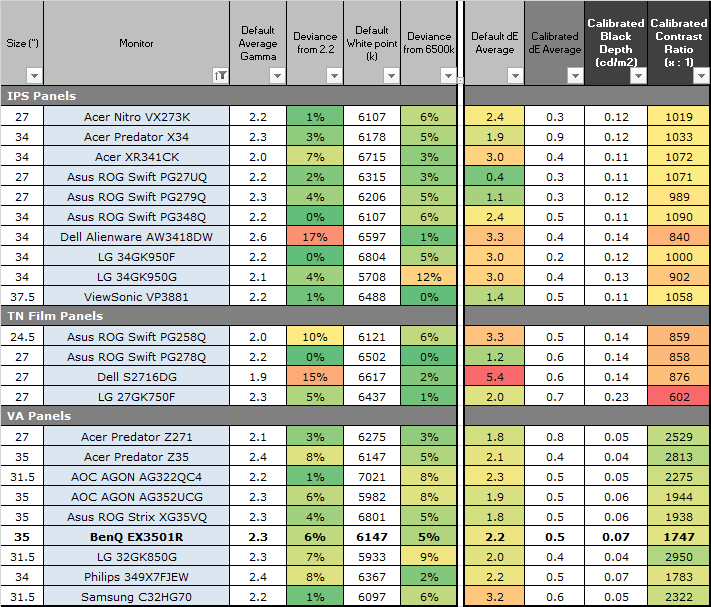
The comparisons made in this section try to
give you a better view of how each screen performs, particularly out of the box
which is what is going to matter to most consumers. We have divided the table up
by panel technology as well to make it easier to compare similar models. When
comparing the default factory settings for each monitor it is important to take
into account several measurement areas - gamma, white point and colour accuracy.
There's no point having a low dE colour accuracy figure if the gamma curve is
way off for instance. A good factory calibration requires all 3 to be well set
up. We have deliberately not included luminance in this comparison since this is
normally far too high by default on every screen. However, that is very easily
controlled through the brightness setting (on most screens) and should not
impact the other areas being measured anyway. It is easy enough to obtain a
suitable luminance for your working conditions and individual preferences, but a
reliable factory setup in gamma, white point and colour accuracy is important
and some (gamma especially) are not as easy to change accurately without a
calibration tool.
From these comparisons we can also compare
the calibrated colour accuracy, black depth and contrast ratio. After a
calibration the gamma, white point and luminance should all be at their desired
targets.
Default setup of the screen out of the box
was fairly good with only a small deviance in the gamma and white point. It's
possible to improve those with just some simple OSD setting changes as well if
you want. Note that the gamut extends a little beyond the normal sRGB reference
(~115% coverage), and there is no emulation mode offered to reduce that if you
needed to do any colour critical or photo editing work specifically with sRGB content.
For normal uses, gaming, multimedia etc the extended colour space will give you
a bit of a boost in colour vividness which looks nice, and does not lead to any
obvious oversaturation or issues.
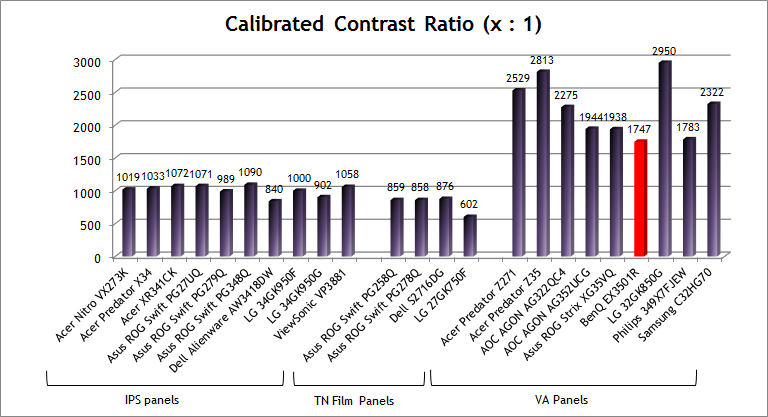
When it comes to black depth and contrast
ratio the screen performed very well thanks to the VA panel. The calibrated
figure of 1747:1 was a fair bit lower than the specified 2500:1 but it still
surpassed anything that IPS or TN Film panels
could offer.
|
Check Pricing and Buy - Affiliate Links
|
|
Amazon |
Overclockers UK
|
|
TFTCentral is a participant
in the Amazon Services LLC Associates Programme, an affiliate
advertising programme designed to provide a means for sites to earn
advertising fees by advertising and linking to Amazon.com, Amazon.co.uk,
Amazon.de, Amazon.ca and other Amazon stores worldwide. We also
participate in a similar scheme for Overclockers.co.uk. |

Viewing Angles

Above: Viewing angles shown from front and side, and from above and below.
Click for larger image
Viewing angles of the screen were moderate.
The image behaved more like older generation VA panels than some of the modern
VA screens we've tested. From a side angle, the image became washed out and pale
in appearance as you can see. Not surprisingly they were very similar to what
we'd seen from the
Asus ROG Strix XG35VQ which features the same AU Optronics panel revision.
They were a little better actually than some older competing models like
the
AOC AGON AG352UCG from March 2017 and
Acer Predator Z35 we tested in January 2016. There was a little less washout
on the EX3501R here than those models which was pleasing. We have seen some
modern VA panels offer better viewing angles with less noticeable gamma and
colour tone shift, such as the
LG 32GK850G. All in all, on the BenQ they were fairly typical VA viewing angles.
The colour tone and gamma shifts were more
noticeable of course than IPS-type panels, including the 34"
Dell Alienware AW3418DW and
Acer Predator X34 as an example. Users should also be aware that the panel
exhibits the off-centre contrast shift which is inherent to the VA pixel
structure. When viewing a very dark grey font for example on a black background,
the font almost disappears when viewed head on, but gets lighter as you move
slightly to the side. This is an extreme case of course as this is a very dark
grey tone we are testing with. Lighter greys and other colours will appear a
little darker from head on than they will from a side angle, but you may well
find you lose some detail as a result. This can be particularly problematic in
dark images and where grey tone is important. It is this issue that has led to
many graphics professionals and colour enthusiasts choosing IPS panels instead,
and the manufacturers have been quick to incorporate this alternative panel
technology in their screens. We would like to make a point that for many people
this won't be an issue at all, and many may not even notice it. Remember, many
people are perfectly happy with their TN Film panels and other VA based screens.
Just something to be wary of if you are affected by this issue or are doing
colour critical work.
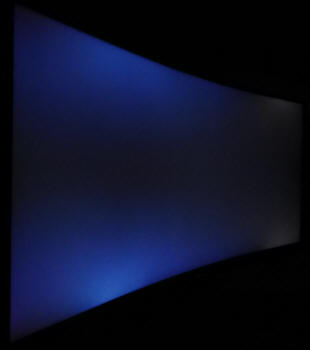
Above: View
of an all black screen from the sides. Click for larger versions
We captured a photo of an all-black image as
viewed from a side angle as shown above. This can help exhibit any glow you
might see on different panel technologies. Here, the actual glow caused by the
VA panel technology was quite low, with some pale areas picked up in the photo.
This side-angle photo actually captures some of the uniformity issues we measure
in the
following section, and you can clearly see the darker and lighter areas of
the screen. From a head on viewing position this is hard to see, but viewing the
screen from a side angle accentuates it. We had seen a very similar situation on
some other 35" ultrawide models like the
Asus ROG Strix XG35VQ and
AOC AGON AG352UCG incidentally.

Panel Uniformity
We wanted to
test here how uniform the brightness was across the screen, as well as identify
any leakage from the backlight in dark lighting conditions. Measurements of the
luminance were taken at 35 points across the panel on a pure white background.
The measurements for luminance were taken using BasICColor's calibration
software package, combined with an X-rite i1 Display Pro colorimeter with a
central point on the screen calibrated to 120 cd/m2. The below
uniformity diagram shows the difference, as a percentage, between the
measurement recorded at each point on the screen, as compared with the central
reference point.
It is worth
noting that panel uniformity can vary from one screen to another, and can depend
on manufacturing lines, screen transport and other local factors. This is only a
guide of the uniformity of the sample screen we have for review.

Uniformity of Luminance

Luminance uniformity of the screen was not very good on our sample, with a
fairly significant difference in luminance in the upper corners. In both the
top left and top right corners the luminance dropped down to 86 cd/m2
(-40% deviance) in the worst case. The central lower region of the screen
was a bit brighter than the calibrated central point as well, reaching up to
127 cd/m2 maximum along the bottom edge. This was not really
noticeable in normal day to day use, or for multimedia at all, but if you
are doing any colour critical work or photo editing, the uniformity
variation may present problems.

Backlight Leakage
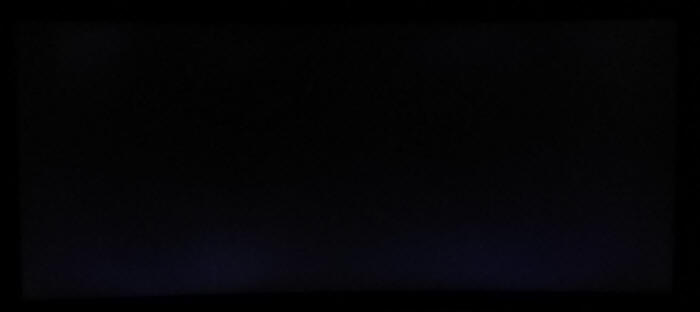
Above: All
black screen in a darkened room. Click for larger version
We also tested the screen with an all black
image and in a darkened room. A camera was used to capture the result. There was
some fairly noticeable clouding and blotching of the backlight along the bottom edge
and in the upper corners. It might be quite hard to pick out from the above photo given the
strong black depth of the VA panel but it was visible in these tests with the
naked eye. You wouldn't notice this in normal day to day use from a head on
viewing position, but you could see these lighter clouded areas on dark content
and from an angle.
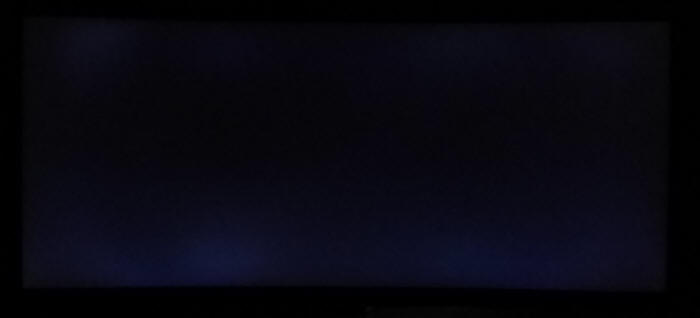
Above:
accentuated by a slow shutter speed to demonstrate areas of backlight clouding. Click for larger version
We have also captured the same photo but at a
slower shutter speed to try and make this clearer in the photo. This is an
exaggeration of what it really looks like to the naked eye, but will highlight
the areas of concern on our sample a bit better than the initial photo.
Note: if you want to test your own screen for
backlight bleed and uniformity problems at any point you need to ensure you have
suitable testing conditions. Set the monitor to a sensible day to day brightness
level, preferably as close to 120
cd/m2 as you can get it (our tests
are once the screen is calibrated to this luminance). Don't just take a photo at
the default brightness which is almost always far too high and not a realistic
usage condition. You need to take the photo from about 1.5 - 2m back to avoid
capturing viewing angle characteristics, especially on IPS-type panels where
off-angle glow can come in to play easily. Photos should be taken in a darkened
room at a shutter speed which captures what you see reliably and doesn't
over-expose the image. A shutter speed of 1/8 second will probably be suitable
for this.

General and Office Applications

One of the key selling points of ultra-wide
screens like the this is it's high resolution and large screen size. The 3440 x
1440 display offers a sharp but comfortable picture. Its pixel area is about 1.8
times larger than an Ultra-Wide Full HD 21:9 monitor, and about 2.4 times larger
than a Full HD 16:9 monitor. It provides an efficient environment in using
Microsoft Office programs showing 47 columns and 63 rows in excel. Thankfully
the high resolution is of a very comfortable size on the 34" panel, with a
0.2384mm pixel pitch is is very comparable to a 27" 2560 x 1440 monitor
(0.2331mm), and only slightly larger than a 34" screen with equivalent
resolution. This means you are basically getting a wider desktop to work with,
with a similar font size to a 27" model, and maintaining the same vertical
resolution as well. If you're coming from a lower resolution / larger pixel
pitch you may still find the fonts look quite small to start with, but like the
27" 1440p models out there you soon get used to it. Side by side multi-tasking
on this screen is excellent and you really do have a nice wide area to work
with. We liked the curved format of the display actually for day to day office
work. It just felt a bit more comfortable than a flat screen on a model as wide
as this, bringing the corners a bit nearer to you. You didn't really notice the
curve in normal use but we liked the feel. Probably down to user taste, so if in
doubt try and see one in person.
The light AG coating of the panel is welcome,
and much better than the grainy and 'dirty' appearance of some other AG coatings
on some displays. The pretty wide
viewing
angles provided helps minimize on-screen colour shift when viewed from different
angles, with no major glow on dark content like you will see from most IPS
panels. There was the normal VA off-centre contrast shift which might mean that
viewing dark content or doing colour critical work is a little more tricky than
on an IPS display.
The default setup of the screen offered a
decent enough performance with only minor 5% deviations for gamma and white
point. There was also a strong contrast ratio thanks to the VA panel technology,
easily surpassing IPS and TN Film panels. In fact you can quite easily improve
the gamma and white point through some simple OSD changes, as detailed in our
calibration section.
The screen has a wider colour space than normal sRGB screens
despite this not really being advertised on BenQ's spec pages,
offering about 115% sRGB coverage / 85% DCI-P3. This is good if you want to work
with wider gamut content or for the intended gaming and HDR uses, but if you
were wanting to specifically work with sRGB standard gamut content for colour
critical work or photo editing then that
might be a problem. There is no more accurate sRGB emulation mode offered by the screen
(the sRGB preset mode doesn't limit the gamut at all) so you
might come up against problems working directly with the smaller sRGB colour
space. It's not a major over-coverage though so it's unlikely to create many
problems unless you are doing a lot of colour critical work.
The
brightness range of the screen was very good, with the ability to offer a
luminance between 310 and 39 cd/m2. This should mean the screen is
perfectly useable in a wide variety of ambient light conditions, including
darkened rooms. A setting of ~27 in the OSD brightness control should return you
a luminance close to 120 cd/m2 out of the box. On another positive
note, the brightness regulation is controlled without the need for
Pulse Width Modulation (PWM), and so those who suffer from eye fatigue or
headaches associated with flickering backlights need not worry.

There was no
audible noise from the screen, even when conducting specific tests which can
sometimes cause issues. There's no specific reading or
text preset mode on the screen as such, so you will need to set up the
'standard' or one of the
'Custom' modes for every day use. There are however 20 different low blue light
settings which will help reduce the blue spectral output of the backlight and
might be useful for reading and office work, making the image a little warmer as
a result as you increase the setting but being kinder to the eyes.
The
Brightness Intelligence Plus (B.I.+) system is am ambient light sensor that can
help reduce eye strain in a any lighting environment. The BenQ spec page says
that "The
ambient light sensor detects ambient light levels and the colour temperature in
your viewing environment, automatically adjusting on-screen brightness and
colour temperature to fit your surroundings. It also gradually adjusts
brightness based on one’s usage time. This offers the best display quality for
users’ viewing comfort, preventing eye strain and protecting your eyes after you
watch monitors for hours." The B.I.+ mode cannot be activated in the custom
preset modes, but is available in the others like the 'standard' preset. Once
enabled, it locks the brightness, contrast, colour temperature and some other
settings in the OSD and then automatically adjusts the screens brightness and
colour temp for you depending on your ambient light conditions. A small OSD
graphic appears sometimes to let you know the brightness level has been adjusted
when there are any major changes.
The screen offers 2x USB 3.0 ports which can
be useful. Both are located on the back of the screen so they aren't super-easy
to access. Might have been nice to have a couple more, and maybe also offer fast
charging support like a lot of other modern screens. There are no integrated
speakers but there is a headphone output if you want. There was a reasonable range
of ergonomic adjustments available from the stand with tilt and height, but no
side to side swivel. The VESA mounting support may also be
useful to some people as well for more flexibility.

Responsiveness and Gaming
|
Panel Manufacturer and
Technology |
AU Optronics AMVA
(VA-type) |
|
Panel Part |
M350QVR01.1 |
|
Quoted G2G Response Time |
4ms G2G |
|
Quoted ISO Response Time |
n/a |
|
Overdrive Used |
Yes |
|
Overdrive Control
Available Via OSD Setting |
AMA setting |
|
Overdrive OSD Settings |
Off, High, Premium |
|
Maximum
Refresh Rate |
100Hz native |
|
Variable
Refresh Rate technology |
AMD FreeSync + Adaptive
Sync |
|
Variable
Refresh Rate Range
|
48 - 100Hz |
|
Blur
Reduction Backlight |
No |
The EX3501R is rated by BenQ as having a
4ms G2G typical response time. The screen uses
overdrive / response time compensation (RTC) technology to boost pixel
transitions across grey to grey changes as with nearly all modern displays.
There is a user control in the OSD menu for the overdrive under the 'AMA'
(Advanced Motion Accelerator) setting with 3 options available as listed above. The part
being used is
an AU Optronics M350QVR01.1 VA technology panel. Have a read
about response time in our
specs section if you need additional information about this measurement.
We use an
ETC M526
oscilloscope for these measurements along with a custom photosensor device.
Have a read of
our response time measurement article for a full explanation of the testing
methodology and reported data.

Overdrive Setting
(AMA)
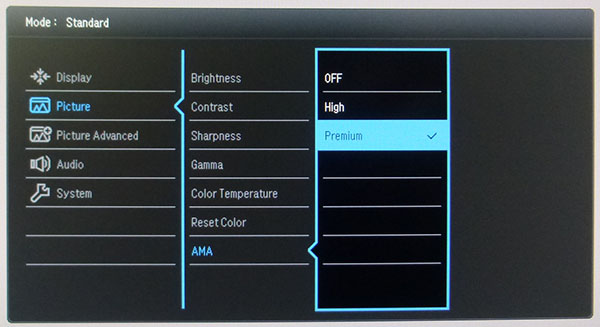
The overdrive control is available via the
AMA (Advanced Motion Accelerator) setting in the OSD menu. We carried out some initial response time
measurements in each of the overdrive settings while running at the maximum
100Hz native refresh rate. The refresh rate does have an impact on the
response times as well, so we will look at that in a moment. Various visual
tests also helped establish the optimal overdrive setting here at 100Hz.



|
With AMA set to 'Off' there was a lot of
blurring on moving content and motion clarity was poor. We measured an average
G2G response time of 16.9ms, although many of the transitions were quite a lot
slower than this up around 20 - 24ms. As with most VA panels we've tested, the
pixel response times were particularly slow when changing from black to grey.
These measurements are shown in the top row of the table where the image starts
on 0 (black) and changed to different grey shades (dark grey at 50 and light
grey 150), and then eventually to white at 255. The changes between black and
dark grey are always the most challenging for VA panels, and there was no
exception here, where 52.5ms was measured with AMA 'off'. In practice, these
slow changes from black > grey result in dark and black smearing behind moving
objects which was distracting. Don't use the AMA 'off' mode.
Pushing the AMA setting up to the middle
'High' setting brought about a few minor changes, but nothing much. In practice
there was very little change to motion clarity, with high levels of blurring
apparent on moving content. Average G2G had dropped now to 14.8ms, although if
we ignore the particular slow 0 > 50 transition (51.5ms on its own) the average
was actually 11.4ms. It's probably better to compare that figure so that the
very high 0 > 50 figure doesn't skew the overall picture too much. This
wasn't much improvement over the 13.7ms G2G average (ignoring the slow 0>50
transition) we'd measured with AMA 'off'. In fact neither the off or high modes
could deliver response times consistently fast enough to keep up with the 100Hz
refresh rate of the screen, where a new frame is sent to the panel every 10ms.
Some of the blurring and smearing is related to that inability to meet the frame
rate in these modes.
We expected the 'Premium' setting to be too
aggressive and result in very large amounts of overshoot (pale or dark halos
behind moving objects), as that's what we've seen on other BenQ screens in the
past. In fact, there was no sign of any real overshoot in our visual or measured
tests which was very pleasing. The 0 > 50 transition was still slow (42.5ms) but most of the other pixel
transitions had been sped up really nicely. We measured an average G2G of 7.2ms,
if we ignore that really slow transition. Moving content looked clearer and
sharper and this was now fast enough to keep up with the 100Hz frame rates.. This definitely seemed to be the optimal AMA setting.
|
|
Key
Quick Information Box
-
Recommend running at 'Premium' AMA overdrive setting and 100Hz wherever
possible
-
Reasonable response times overall for a VA panel
-
Some
common problematic changes from black > grey shades
-
Some
black smearing evident in practice, when changing from black to dark
colours
-
Response times do vary a bit depending on the refresh rate
-
At
60Hz (for consoles etc) stick with the 'Premium' AMA setting as well
|
|

Refresh Rate


The comparisons in the 'Overdrive (AMA)' section
were done at the maximum 100Hz refresh. Like many high refresh rate screens,
especially those with AMD FreeSync, the response time behaviour varies depending on the active refresh rate. We completed the same
measurements again while using the 'premium' overdrive setting, but also at a
lower 60Hz.
We probably need to ignore the 0 > 50
transition here for a moment to draw some comparisons, which remained slow at
both refresh rates. The other response times were a fair bit slower at 60Hz than
they had been at the full 100Hz setting. We measured an average 9.2ms G2G now,
instead of 7.2ms before. Motion tests showed higher levels of blur and reduced
motion clarity because of the response times, but also because of the drop in
refresh rate. Refresh rate has a direct impact on the perceived levels of motion
blur on an LCD display, and there is a definite and obvious improvement going from 60 to 100Hz on
this and other screens.
There is certainly a lot less blurring at the
higher refresh rates, and it is easier to track moving objects across the
screen. We would recommend running the screen at the maximum refresh rate if you
are able to push the screen to these levels from your graphics card and system.
That might vary by game, and over time it will become easier to run 3440 x 1440 @ 100Hz as graphics cards improve too.
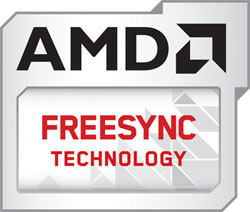
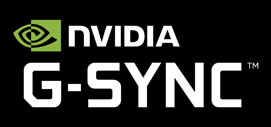
One important feature of this screen is the
support for AMD FreeSync which offers support for variable refresh rates,
helping to avoid tearing and stuttering in games without introducing the lag
associated with older Vsync options. It's a very useful technology for when your frame rates fluctuate, especially
considering it will take a pretty powerful system to run the screen at its native
3440 x 1440 resolution @ 100Hz. FreeSync is supported from compatible
AMD graphics cards. The FreeSync range is 48 - 100Hz.
With
the recent January 2019 announcement, NVIDIA users with modern gaming cards can also now take
advantage of the variable refresh rate (VRR) technology, despite it not being a
typical G-sync screen. The EX3501R is not one of the initial 12 screens which
NVIDIA have certified as "G-sync Compatible", but that's not to say that you
can't still use G-sync VRR anyway. You need to have a compatible graphics card
and the latest drivers, but it is possible to then enable G-sync in the OSD menu
and make use of the VRR on this display. Again useful to have that support for
VRR from NVIDIA systems as well.
There is no added blur reduction backlight on
this model. We have written
a detailed article about such blur reduction backlights so we would
encourage you to read that if you are unfamiliar with how these operate and the
benefits they can produce on other displays. Some people aren't bothered by these strobed
backlights and would rather game with FreeSync and a flicker free experience
anyway, so for some people it won't be missed. Others like to use them and may
be a bit disappointed that it is not provided here.

Detailed Response Time Measurements
Overdrive AMA mode = Premium
Refresh Rate = 100Hz

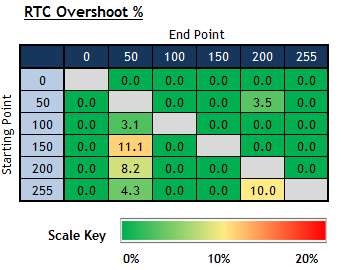

Having determined that the screen performed
the best at its maximum 100Hz refresh rate and with the AMA overdrive set to
'Premium', we carried out some further tests over a wider range of pixel
transitions. The average G2G response time was now measured at 8.7ms average
overall,
although if we ignore the couple of very slow transitions marked in red, the
average was actually 7.5ms G2G which was good. Some transitions reached down to around the 4ms
spec (3.5ms in fact was the fastest measured).
This is just comfortably fast enough to keep up with
the high 100Hz refresh rate which is good news, as otherwise additional blurring
and smearing can be added in moving content. There were a couple of pixel
transitions when changing from black > dark grey which were a lot slower
(marked in red, reaching up to 42.5ms in the worst case example), which is a fairly
typical behaviour for a VA panel. This only impacted the changes between black
and dark/medium grey shades, and so the black smearing was not overly obvious. It was
less than we'd seen on some other VA panels where the slow transitions also
affect to a higher degree the changes from black to lighter grey shades, and becomes more problematic.
Nevertheless you see black smearing on darker backgrounds and content like most
VA panels.
At this maximum refresh rate and 'Premium'
AMA overdrive setting there was very little overshoot evident, and only a couple of
transitions showing anything of any note. We also know from our earlier tests that
if you lower that refresh rate, or it dips lower when using VRR, the
overshoot reduces further so we don't expect you'd see any real issue with
overshoot on this screen. You get a slight pale halo on some content, but it's
not very noticeable in practice unless looking very closely for it.

Gaming Comparisons

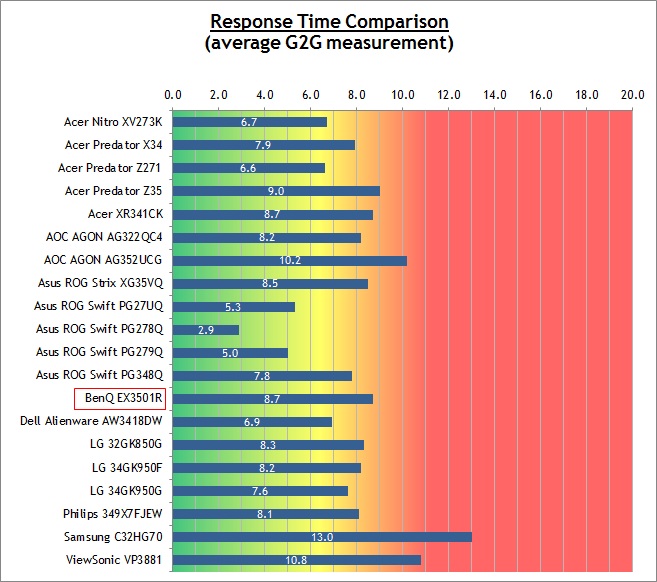
We have provided a comparison of the EX3501R
against many other screens we have reviewed. At the optimal settings (100Hz,
overdrive set to 'Premium') the performance was good for a VA panel, with an
average 8.7ms G2G measured here and moderate
levels of black smearing for a VA panel. It also had low levels of overshoot at
these settings which was great news. It was faster overall than some other 35"
models we've tested like the AOC AGON AG352UCQ and Acer Predator Z35 for
instance. Some of these other models in the table above offer higher refresh
rates keep in mind, which can help improve motion clarity further as well.

Additional
Gaming Features
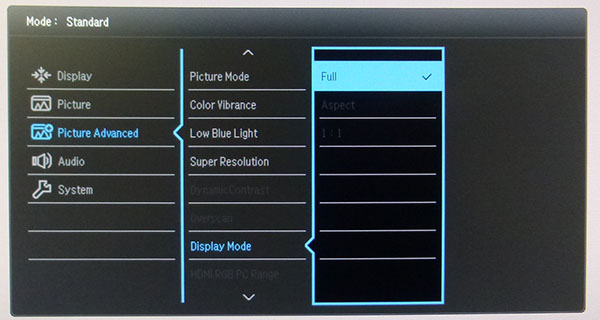

Lag
We have written an in depth article about
input lag and the various measurement techniques which are used to evaluate
this aspect of a display. It's important to first of all understand the
different methods available and also what this lag means to you as an end-user.
Input Lag vs. Display Lag vs. Signal
Processing
To avoid confusion with different terminology
we refer to this section of our reviews as just "lag", as there
are a few different aspects to consider, and different interpretations of the
term "input lag". We will consider the following points here as much as
possible. The overall "display lag" is the first, that being the delay between
the image being shown on the TFT display and that being shown on a CRT. This is
what many people will know as input lag and originally was the measure made to
explain why the image is a little behind when using a CRT. The older simple stopwatch
based methods were the common way to measure this in the past, but through
advanced studies have been shown to be quite inaccurate. As a result, more
advanced tools like SMTT provide a method to measure that delay between a TFT
and CRT while removing the inaccuracies of older stopwatch methods.
In reality that lag / delay is caused by a
combination of two things - the signal processing delay caused by the TFT
electronics / scaler, and the response time of the pixels themselves. Most
"input lag" measurements over the years have always been based on the overall
display lag (signal processing + response time) and indeed the SMTT tool is
based on this visual difference between a CRT and TFT and so measures the
overall display lag. In practice the signal processing is the element which
gives the feel of lag to the user, and the response time of course can
impact blurring, and overall image quality in moving scenes. As people become
more aware of lag as a possible issue, we are of course keen to try and
understand the split between the two as much as possible to give a complete
picture.
The signal processing element within that is
quite hard to identify without extremely high end equipment and very complicated
methods. In fact the studies by Thomas Thiemann which really kicked this whole
thing off were based on equipment worth >100,000 Euro, requiring extremely high
bandwidths and very complicated methods to trigger the correct behaviour and
accurately measure the signal processing on its own. Other techniques which are
being used since are not conducted by Thomas (he is a freelance writer) or based
on this equipment or technique, and may also be subject to other errors or
inaccuracies based on our conversations with him since. It's very hard as a
result to produce a technique which will measure just the signal processing on
its own unfortunately. Many measurement techniques from those trying to measure
lag are also not explained and so
it is important to try and get a picture from various sources if possible to
make an informed judgement about a display overall.
For our tests we will continue to use the
SMTT tool to measure the overall "display lag" which has been proven
to be a reliable and accurate measurement tool. From there we can use our
oscilloscope system to measure the response time across a wide range of grey to
grey (G2G) transitions as recorded in our response time
tests earlier in the review. Since SMTT will not include the full response time within its
measurements, after speaking with Thomas further about the situation we will
subtract half of the average G2G response time from the total display lag. This
should allow us to give a good estimation of how much of the overall lag is
attributable to the signal processing element on its own.
Lag Classification
To help in this section we will also introduce a broader classification system
for these results to help categorise each screen as one of the following levels.
We will now keep these classifications consistent regardless of the actual
refresh rate of the screen being measured:
-
Class 1)
Less than 8.33ms - the equivalent to 1 frame lag of a display at 120Hz refresh
rate - should be fine for gamers, even at high
levels
-
Class 2)
A lag of 8.33 -
16.66ms
- the equivalent of one to two frames at a 120Hz refresh rate - moderate lag but should be fine for many gamers.
Caution advised for serious gaming
-
Class 3)
A lag of more than
16.66ms - the equivalent of more than 2 frames at a refresh rate of 120Hz - Some noticeable lag in daily usage, not
suitable for high end gaming

For the full reviews of the
models compared here and the dates they were written (and when screens were
approximately released to the market), please see our
full
reviews index.
|
|
Measurements in ms |
|
Total Display Lag
(SMTT 2) |
7.00 |
|
Pixel Response Time
Element |
4.35 |
|
Estimated Signal
Processing Lag |
2.65 |
|
Lag Classification |
1 |
|

Class
1 |
We have provided a comparison above against
other models we have tested to give an indication between screens. The screens
tested are split into two measurements which are based on our overall display
lag tests (using SMTT) and half the average G2G response time, as measured by
the oscilloscope. The response time is split from the overall display lag and
shown on the graph as the green bar. From there, the signal processing (red bar)
can be provided as a good estimation.
The screen showed a total lag of only 7ms
overall. With ~4.35ms of that accounted for by pixel response times, we can
estimate a signal processing lag of approximately 2.65ms. This is next to
nothing and should represent no problem for fast gaming. A pleasing result as
often FreeSync screens can show higher lag levels.

Movies and Video
The following summarises the screens
performance for videos and movie viewing:
|
Category |
Display
Specs / Measurements |
Comments |
|
Size |
35" widescreen |
Large for
desktop display |
|
Aspect Ratio |
21:9 |
Can support wider screen
content than common 16:9 which is useful for movies |
|
Resolution |
3440 x 1440 |
Can support native 1080p
content, but not quite Ultra HD natively which requires a higher vertical
resolution of 2160. |
|
HDCP |
Yes |
Suitable for encrypted
content |
|
Connectivity |
DisplayPort 1.4, 2x HDMI 2.0
and 1x USB type-C |
Useful additional 2x HDMI
input for external Blu-ray players or games consoles. |
|
Cables |
DisplayPort > Mini DP, and HDMI |
Both provided in the box
which is good news |
|
Ergonomics |
Tilt, height |
Useful to have tilt and
height, but swivel adjustment might be missed if you're wanting to use the
screen from a different viewing position than normal desk usage |
|
Coating |
Light Anti-glare |
Provides clear, non-grainy
image and avoids unwanted reflections of full glossy solutions |
|
Brightness range |
39 - 310 cd/m2 |
Good adjustment range
offered. Flicker free backlight operation with no PWM |
|
Contrast |
1747:1 after calibration |
Strong contrast ratio
thanks to VA panel, helping provide good clarity in shadow detail and darker
content. A strength of this technology and easily surpassing other panel
technologies. |
|
Preset modes |
'HDR' mode |
No specific movie preset
mode in the menu, but you can set one of the two 'custom' modes to your
liking if you want something different to general or gaming uses. There is
an HDR preset which "emulates" HDR (not really doing anything HDR-like) but
could be used as your movie preset mode |
|
Response times |
8.7ms G2G, minimal overshoot at
100Hz, but 11.5ms at 60Hz |
Response time behaviour
varies depending on refresh rate. You will need to change to the 'Premium'
AMA
overdrive mode for optimal performance, including for 60Hz external devices. Reasonable overall
although some dark transitions are still slow due to the VA panel and may
result in some black smearing on certain transitions. |
|
Viewing angles |
Good |
Not as wide as IPS, and
fairly typical for a VA panel. Free from the pale "IPS-glow" on dark content when
viewed from an angle that you see on IPS panels although some uniformity
issues become apparent from an angle on dark content |
|
Backlight bleed |
Poor (will vary) |
Some fairly noticeable
backlight clouding on our sample, pretty apparent in darker room conditions.
Will vary from sample to sample. |
|
Audio |
Headphone out |
No integrated speakers
but there is a headphone output provided |
|
Aspect Ratio Controls |
Full, Aspect and 1:1 |
Good options to account for
non-native aspect ratio inputs if needed which is useful as many are 16:9
and not the 21:9 of this display |
|
PiP / PbP |
Both available |
Might be useful for some
people |
|
HDR support |
No real support |
Despite being heavily
promoted as an HDR display, there is no real HDR
support from this screen. There is no local dimming to support
improvements in the dynamic range which is really the foundation of HDR in
the first place. There is no increased
peak brightness offered, being limited to around 300 cd/m2 maximum. The
panel colour depth is also 8-bit and not the required 10-bit.
However, there is a
modest boost in colour space thanks
to the 115% sRGB / 85% DCI-P3 gamut offered at least from the backlight,
although oddly this is one of the areas BenQ don't promote on their spec
page! The screen has the necessary HDR-ready inputs, and can accept an HDR
input signal, but there's no real benefits in terms of display output
beyond a normal screen other than that slightly improved colour space. |

Conclusion
If you
would like to help support our continued work please consider making a
donation
no matter how small or large. Thank you for the continued support.
The EX3501R was a solid all round screen we
felt in the ultrawide market. The VA panel delivered a good image quality with
the usual high contrast ratio and deep blacks that you would expect from this
panel technology. The 3440 x 1440 resolution and 35" screen size provided a
really nice, comfortable desktop area for general office-type work and every day
use, and the default setup was also fairly decent. It was also easy to make a
few tweaks to the settings in the OSD to produce a good gamma, white point and
colour setup without much fuss. BenQ's usual focus on eye care was of course
welcome, with the flicker free backlight, large range of blue light filter
settings and the pretty useful ambient light sensor as well.
If you look at the BenQ spec page and
marketing material, the EX3501R is aimed at multimedia and HDR primarily, and to
a lesser extent gaming. The display is pretty good for movies and video thanks
to the ultrawide format, strong contrast ratio, decent enough viewing angles and
good range of video inputs. However, advertising it primarily as an HDR display
is a bit misleading. Yes, it can accept an HDR input signal, but it lacks nearly
all the specs and features that produce an actual HDR output from the screen.
There is no backlight local dimming of any type to actually extend the dynamic
range - a vital part of any display attempting to offer HDR. We guess you
could say that the dynamic range produced by the panel is better than TN Film
and IPS panels because of the higher default contrast ratio, but it's not
offering anything beyond its static contrast ratio capabilities. The maximum
brightness is only around 300 cd/m2, whereas HDR displays should be
able to offer peak brightness up much higher than that for highlights in
content. The panel also lacks the necessary 10-bit colour depth support for HDR
content, being limited to only a traditional 8-bit depth. The only area where
the EX3501R actually delivers something close to the HDR spec requirements is
with the colour gamut, where we measured around 85% DCI-P3 coverage. Usually for
HDR monitors this needs to be >90%, but it was still a boost above a typical
sRGB screen and helped produce more vivid colours for HDR content. Oddly though,
this was the one thing BenQ don't even talk about in their spec pages! There are
the necessary video input connections to allow you to send an HDR signal to the
display from compatible devices, but it's all pretty pointless as the screen
isn't capable of really producing anything close to an HDR output experience.
HDR aside then, we found the gaming
experience to be pretty decent on the screen. The response times were fairly
typical for a VA panel with some problematic transitions from black to grey, and
some black smearing on darker content as a result. However, the other response
times were good and there was no real overshoot thankfully. The 100Hz native
refresh rate helped improve motion clarity and gaming experience nicely compared
with the wide range of 60Hz displays out there. Variable Refresh Rate (VRR)
support for both AMD and NVIDIA systems (with relevant modern graphics cards)
was welcome too, and the input lag was very low which was great news.
Overall if we ignore the fact it's clearly
marketed as an HDR display when it can't live up to that claim, the EX3501R is a
solid all rounder and performs nicely in a wide range of uses and applications.
The EX3501R is available from most regions via
Amazon and also from
Overclockers
in the UK (affiliate links).
|
Pros |
Cons |
|
Good all round
performance from VA panel, with strong contrast ratio |
HDR market position is
misleading, no real HDR performance |
|
Decent gaming experience
with 100Hz refresh rate, VRR support, very low lag and decent enough
response times |
Missing swivel adjustment
from the stand |
|
Good size, resolution and
format for general uses |
Some slow response times
leading to typical VA black smearing in some cases |
|
Check Pricing and Buy - Affiliate Links
|
|
Amazon |
Overclockers UK
|
|
TFTCentral is a participant
in the Amazon Services LLC Associates Programme, an affiliate
advertising programme designed to provide a means for sites to earn
advertising fees by advertising and linking to Amazon.com, Amazon.co.uk,
Amazon.de, Amazon.ca and other Amazon stores worldwide. We also
participate in a similar scheme for Overclockers.co.uk. |